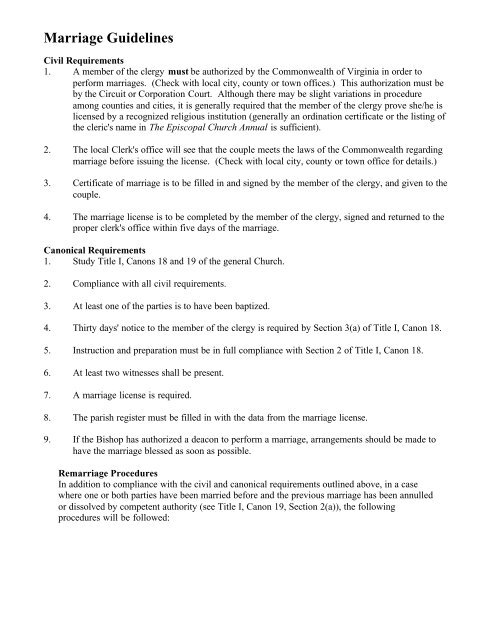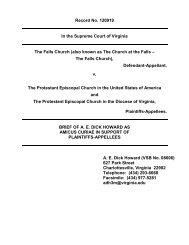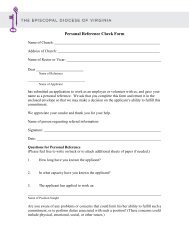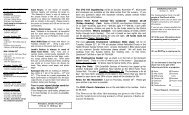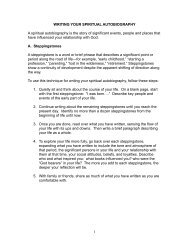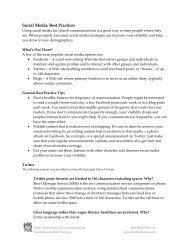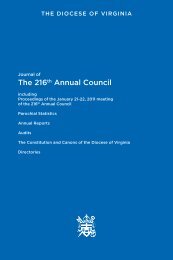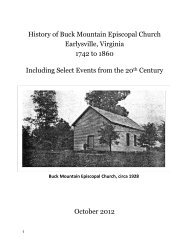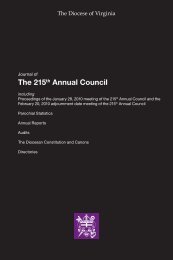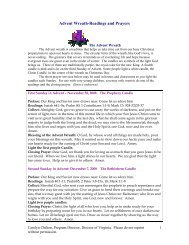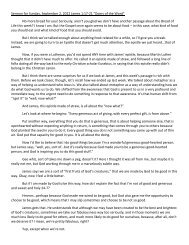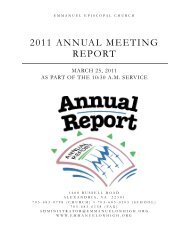Guidelines for Marriage & Remarriage - Diocese of Virginia
Guidelines for Marriage & Remarriage - Diocese of Virginia
Guidelines for Marriage & Remarriage - Diocese of Virginia
You also want an ePaper? Increase the reach of your titles
YUMPU automatically turns print PDFs into web optimized ePapers that Google loves.
<strong>Marriage</strong> <strong>Guidelines</strong><br />
Civil Requirements<br />
1. A member <strong>of</strong> the clergy must be authorized by the Commonwealth <strong>of</strong> <strong>Virginia</strong> in order to<br />
per<strong>for</strong>m marriages. (Check with local city, county or town <strong>of</strong>fices.) This authorization must be<br />
by the Circuit or Corporation Court. Although there may be slight variations in procedure<br />
among counties and cities, it is generally required that the member <strong>of</strong> the clergy prove she/he is<br />
licensed by a recognized religious institution (generally an ordination certificate or the listing <strong>of</strong><br />
the cleric's name in The Episcopal Church Annual is sufficient).<br />
2. The local Clerk's <strong>of</strong>fice will see that the couple meets the laws <strong>of</strong> the Commonwealth regarding<br />
marriage be<strong>for</strong>e issuing the license. (Check with local city, county or town <strong>of</strong>fice <strong>for</strong> details.)<br />
3. Certificate <strong>of</strong> marriage is to be filled in and signed by the member <strong>of</strong> the clergy, and given to the<br />
couple.<br />
4. The marriage license is to be completed by the member <strong>of</strong> the clergy, signed and returned to the<br />
proper clerk's <strong>of</strong>fice within five days <strong>of</strong> the marriage.<br />
Canonical Requirements<br />
1. Study Title I, Canons 18 and 19 <strong>of</strong> the general Church.<br />
2. Compliance with all civil requirements.<br />
3. At least one <strong>of</strong> the parties is to have been baptized.<br />
4. Thirty days' notice to the member <strong>of</strong> the clergy is required by Section 3(a) <strong>of</strong> Title I, Canon 18.<br />
5. Instruction and preparation must be in full compliance with Section 2 <strong>of</strong> Title I, Canon 18.<br />
6. At least two witnesses shall be present.<br />
7. A marriage license is required.<br />
8. The parish register must be filled in with the data from the marriage license.<br />
9. If the Bishop has authorized a deacon to per<strong>for</strong>m a marriage, arrangements should be made to<br />
have the marriage blessed as soon as possible.<br />
<strong>Remarriage</strong> Procedures<br />
In addition to compliance with the civil and canonical requirements outlined above, in a case<br />
where one or both parties have been married be<strong>for</strong>e and the previous marriage has been annulled<br />
or dissolved by competent authority (see Title I, Canon 19, Section 2(a)), the following<br />
procedures will be followed:
Preface to the Diocesan <strong>Guidelines</strong><br />
The polices <strong>of</strong> the <strong>Diocese</strong> <strong>of</strong> <strong>Virginia</strong> <strong>for</strong> solemnization <strong>of</strong> marriage after divorce, consistent<br />
with the Canons <strong>of</strong> the Episcopal Church, are based on two Christian truths: that marriage is a<br />
lifelong union <strong>of</strong> a man and a woman, instituted <strong>of</strong> God, signifying the union between Christ and<br />
his Church; and that God, in his infinite mercy and redeeming love, creates new life in death,<br />
gives hope where there is despair, and <strong>for</strong>gives our sins. So the Church maintains its belief in the<br />
will <strong>of</strong> God <strong>for</strong> lifelong marriages that are signs <strong>of</strong> his steadfast love and at the same time, with<br />
no dilution <strong>of</strong> that belief, the Church may bless the unions <strong>of</strong> those whose prior marriages have<br />
died, and who, in faith, while accepting the consequences <strong>of</strong> their prior commitments, covenant<br />
with one another in a mature Christian marriage.<br />
These guidelines seek to assist persons in building strong marriages after the deaths <strong>of</strong> their prior<br />
marriages. The Church's experience has taught that time is necessary <strong>for</strong> healing, <strong>for</strong> learning<br />
and <strong>for</strong> <strong>for</strong>giveness. So the norm is that at least one year will have lapsed between the final<br />
decree <strong>of</strong> divorce and the date <strong>of</strong> the petition. (If one year has not elapsed, at least 18 months <strong>of</strong><br />
uninterrupted separation must occur be<strong>for</strong>e consent is granted.) The guidelines also seek to<br />
assist persons in resolving issues left from a prior marriage and in accepting responsibility <strong>for</strong><br />
commitments, such as child support, that continue from the prior marriage. The guidelines<br />
deliberately discourage unions that are <strong>for</strong>med in reaction to the stresses <strong>of</strong> a prior union; hence<br />
the emphasis on time to heal and time to settle issues from a prior union.<br />
When a person approaches the Church seeking to marry <strong>for</strong> the third or more time, the guidelines<br />
assume that additional pr<strong>of</strong>essional consultation is appropriate to assist the member <strong>of</strong> the clergy<br />
in the exercise <strong>of</strong> the pastoral ministry.<br />
These guidelines provide a minimum diocesan standard that places substantial responsibility <strong>for</strong><br />
judgment on the member <strong>of</strong> the clergy. The guidelines assume that the local pastor is in the best<br />
position to make the subjective judgments regarding the wisdom <strong>of</strong> the proposed marriage. The<br />
guidelines seek to provide a coherent framework in which that judgment is to be made and a<br />
consistent set <strong>of</strong> standards <strong>for</strong> the <strong>Diocese</strong> <strong>of</strong> <strong>Virginia</strong>.<br />
In most situations where there has been only one divorce or only one <strong>for</strong> each party, and where<br />
the member <strong>of</strong> the clergy can respond affirmatively to all questions on the Petition, episcopal<br />
consent will be granted.<br />
This process requires the conscientious attention <strong>of</strong> the clergy to the questions asked. The<br />
guidelines, it is hoped, will support the clergy in their ministry, simplify procedures where<br />
appropriate and maintain a diocesan-wide standard that is pastorally sensitive and theologically<br />
sound.<br />
<strong>Guidelines</strong> <strong>for</strong> Petitioning <strong>for</strong> Consent<br />
to Solemnize <strong>Marriage</strong>s after Divorce or Annulment<br />
1. The member <strong>of</strong> the clergy seeking the Bishop's consent to solemnize such a marriage<br />
petitions the Bishop using the Diocesan Petition. (The Petition is in addition to, and not a<br />
substitute <strong>for</strong>, the requirements <strong>of</strong> the Canons).
No date <strong>for</strong> marriage should be firmly set and none announced until consent has been<br />
received. No petition will be considered unless all final decrees <strong>of</strong> divorce have been<br />
issued.<br />
The Bishop must be notified immediately following the solemnization <strong>of</strong> such a<br />
marriage.<br />
2. Where one or both parties have been divorced (or his or her marriage(s) annulled) more<br />
than once, the member <strong>of</strong> the clergy is expected to refer the couple to a licensed<br />
pr<strong>of</strong>essional counselor or a certified pastoral counselor (e.g., a licensed psychiatrist,<br />
psychologist, or a pastoral counselor accredited by a pr<strong>of</strong>essional association), such<br />
counselor to be satisfactory to the member <strong>of</strong> the clergy, <strong>for</strong> consultation at the expense<br />
<strong>of</strong> the couple. The consultation is to be considered a source <strong>of</strong> an additional opinion to<br />
support the member <strong>of</strong> the clergy in the exercise <strong>of</strong> pastoral judgment.<br />
After such consultation and counseling as the pr<strong>of</strong>essional counselor may require, the<br />
member <strong>of</strong> the clergy should receive a written statement from the counselor, together<br />
with a release from the couple authorizing release <strong>of</strong> the statement. The counselor's<br />
statement should express his or her opinion that whatever issues were involved in the<br />
dissolution <strong>of</strong> the <strong>for</strong>mer marriages appear to be sufficiently resolved and that, in the<br />
counselor's opinion, the couple has a reasonable chance to establish a lifetime union <strong>of</strong><br />
mature intimacy. A copy <strong>of</strong> that report must be attached to the Petition.<br />
In situations where the person married more than once received pr<strong>of</strong>essional counseling<br />
at the time <strong>of</strong> or subsequent to the dissolution <strong>of</strong> the <strong>for</strong>mer marriages, a statement from<br />
that counselor to the effect that the person involved has adequately resolved the issues<br />
related to the <strong>for</strong>mer marriages and is prepared <strong>for</strong> a lifelong commitment may be<br />
sufficient.<br />
3. Holy Matrimony is entered into within the community <strong>of</strong> faith and the liturgy <strong>for</strong> the<br />
Celebration and Blessing <strong>of</strong> a <strong>Marriage</strong> emphasizes the congregation's responsibility in<br />
upholding the couple in their marriage. It is a reasonable expectation, there<strong>for</strong>e, that the<br />
couple, or at least one party with the support <strong>of</strong> the other, intends to live out their<br />
marriage in the community <strong>of</strong> faith as members <strong>of</strong> some congregation. The <strong>of</strong>ficiant is<br />
most appropriately a member <strong>of</strong> the clergy <strong>of</strong> that congregation or one who is acting on<br />
behalf <strong>of</strong> and with the consent <strong>of</strong> the couple's pastor. Pastoral concerns may make it<br />
appropriate <strong>for</strong> another member <strong>of</strong> the clergy to submit the Petition.<br />
4. When all questions in the Petition are answered "Yes," consent will be routinely granted.<br />
All Petitions are to be submitted to the Bishop <strong>of</strong> <strong>Virginia</strong>, 110 West Franklin Street,<br />
Richmond, <strong>Virginia</strong> 23220. When any answers on the Petition are checked "No," the<br />
Petition must be accompanied by a thorough letter from the member <strong>of</strong> the clergy<br />
submitting the petition explaining the circumstances.
Explanatory letters should also be sent with any Petition when the circumstances are such<br />
that the member <strong>of</strong> the clergy considers a more thorough consultation to be necessary or<br />
useful.<br />
When questions 1-15 on the Petition are answered "Yes," and question 16 is not<br />
applicable, the Petition may be submitted without any additional documents or letters.<br />
5. These guidelines, and those on the Petition, are in addition to the rubrics <strong>of</strong> the Book <strong>of</strong><br />
Common Prayer and the provisions <strong>of</strong> Title I, Canons 18 and 19 <strong>of</strong> the Canons <strong>of</strong> the<br />
National Church.<br />
6. The Petition <strong>of</strong>fers guidelines. There may be circumstances, outlined in accompanying<br />
explanatory letters, where sound pastoral judgment requires an adjustment in the<br />
guidelines. For example, while one year is a reasonable length <strong>of</strong> time between a final<br />
decree <strong>of</strong> divorce and the submission <strong>of</strong> the Petition, there may be situations where a<br />
couple has been separated but not divorced <strong>for</strong> a substantial period <strong>of</strong> time, allowing the<br />
time necessary <strong>for</strong> healing, and those circumstances should be explained in the letter<br />
accompanying the Petition. Clergy should not submit a request <strong>for</strong> a shortening <strong>of</strong> the<br />
time period until a final decree has been issued regarding the prior marriage, and unless a<br />
minimum <strong>of</strong> 18 months have passed since actual separation from the previous marriage.<br />
Letters requesting exception to the "one year" guideline should address specific reasons<br />
<strong>for</strong> the exception. These unusual circumstances will be considered by the Bishop, but it is<br />
expected that in most circumstances the guidelines will be followed. Clergy are asked to<br />
maintain these standards and to request exceptions only in unusual circumstances, and<br />
only if the 18 months' uninterrupted separation has occurred.<br />
7. A member <strong>of</strong> the clergy or a parish may maintain additional standards consistent with<br />
these guidelines and the canons, e.g., required number <strong>of</strong> counseling sessions,<br />
membership status in the parish prior to marriage, required personal statements reflecting<br />
on the <strong>for</strong>mer marriages to be submitted to the member <strong>of</strong> the clergy. These guidelines,<br />
the Prayer Book, and the Canons provide a minimum standard <strong>for</strong> the <strong>Diocese</strong> <strong>of</strong><br />
<strong>Virginia</strong>.<br />
Issued October 25, 1985<br />
Revised May 1988, Reviewed August 1992, Revised November 1994, November 1995, September<br />
1998.<br />
f:\jyo\clergy <strong>for</strong>ms\marriage \marriage guidelines


